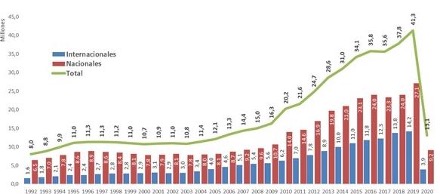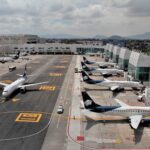After seven months of aviation paralysis as a result of the pandemic in 2020, during 2021 Colombia consolidated its new take-off to reactivate its skies and boosted its international connectivity thanks to the arrival of new operators and the opening of a large number of routes.
To be precise, there have been 12 airlines that announced the entry into operation of 31 new international air routes that allowed the arrival of approximately 1,832,000 visitors, as estimated by the Ministry of Commerce.
Punta Cana in the Dominican Republic, New York, Orlando, Newark in the United States, Cancun and Mexico City in Mexico; Lima in Peru, Montreal in Canada, and Santiago de Chile, have received new routes from Colombia, while connections with Mexico City, Santiago, Miami, Cancun, New York, Panama City, and Toronto have been inaugurated in the country.
Thanks to this «Boom» of new routes, new international connections are available to more Colombian cities, thus enabling the arrival of more travelers and the reactivation of sectors such as tourism. Barranquilla, Pereira, Bucaramanga, and Armenia aroused the interest of more airlines and added new connections, while San Andrés and Cúcuta have for the first time new international routes with Miami and Panama City, respectively, through American Airlines and Copa flights.

Ricardo Galindo Bueno, Vice Minister of Tourism, highlighted that the arrival of new airlines and routes in the country «allows us to consolidate a very good work from the Government, so far the most important year for Colombian tourism».
The national government’s commitment to strengthen the country’s air connectivity has a strategic objective: to boost tourism as an economic reactivation engine.
As a result of this strategy, one of the most important key movements in air connectivity was implemented: the reduction of VAT on airline tickets from 19% to 5%, a major achievement thanks to the approval by Congress of the Tourism Law.
In this way, the country has become a leader in aviation reactivation in the region. According to the Director of the Aerocivil, Jair Orlando Fajardo, «In the first nine months of 2021, 16 million passengers transited through El Dorado, which represents 80 percent of air travelers, including domestic and international passengers, which totaled 20 million. In addition, 625,000 tons of air cargo were handled in the country, mostly through the Bogota airport».
In this way, the country has become a leader in aviation reactivation in the region. According to the Director of the Aerocivil, Jair Orlando Fajardo, «In the first nine months of 2021, 16 million passengers transited through El Dorado, which represents 80 percent of air passengers, including domestic and international traffic, which totaled 20 million. In addition, 625,000 tons of air cargo were handled in the country, mostly through the Bogota airport».
This strategy was also accompanied by an investment by the national government to improve the country’s airport infrastructure and thereby allow new routes to reach new cities.
In this order, Leticia improved its capacity to receive A320 and B737 aircraft; Pasto received investments of $ 177,000 million, and in Armenia, a new control tower was built, the runway and aprons were extended, and finally, a modern terminal was built to open the door to international flights, works in which $ 116,000 million were invested.
Likewise, during 2021 Colombia experienced another unprecedented phenomenon: the increase of the Low-Cost model.
During the year, Viva Air «spared no expense» with an ambitious expansion plan that includes the permission to operate more than 30 international routes; 16 to the United States, four to Mexico, three to the Dominican Republic as well as to Peru, two each to El Salvador and Panama, and one route each to Brazil, Guatemala, and Aruba. A strategy that would position it as the largest Low-Cost carrier in the region.
Likewise, Mexico’s Viva Aerobus and Volaris, together with Spirit, SkyAirlines, JetSmart and the future Ultra Air, have turned Colombia into a land of the low-cost model, an air revolution that has democratized access to air transportation and given more Colombians the opportunity to travel by air.
However, the country’s air development still has a pending task, which is at Bogota’s El Dorado Airport, a terminal that suffers from heavy congestion and has provoked criticism from airline operators.
Just as Avianca’s CEO, Adrian Neuhauser, did at the beginning of December when he made a strong criticism of the airport’s operational problems, which affect up to 80 flights per day of the airline.
According to the executive, the combination of the operation with private and military flights, the limited space for aircraft, and delays in migration processes, result in delays that can affect more than 12,000 Avianca customers per day. He also made a call to solve these «operational inefficiencies» that in the last year have affected more than 4,000 flights and around 500,000 travelers.
Fajardo is optimistic and affirms that Aerocivil is working on alternatives to ease the operation of El Dorado, including the possibility that some non-scheduled flights may operate from Guaymaral airport to help relieve congestion at the country’s main airport.
Yet, at the moment there seems to be no light at the end of the tunnel and the pressure keeps taking its toll on the terminal. IATA has even intervened and sent the following recommendations to the Colombian authorities to solve the operational problems:
- Not to apply Ground Delay Program (GDP) to the airlines, so that the strategic planning previously approved to the airlines is complied with.
- To prioritize scheduled passenger aviation mainly during peak hours of operation at El Dorado airport.
- Not to approve any non-scheduled flights during peak hours.
- To restrict general aviation flights only to those within the approved allocation for off-peak hours and not exceeding the allocated quota.
- To ensure that ATC centers and control towers are adequately staffed for smooth and timely operations.

To conclude, Colombia’s positive progress has projected it as a leader in the region in terms of aviation, the arrival of new operators and the opening of new routes have transformed the country’s connectivity into economic reactivation.
The heavy congestion of the terminal has caused more and more airlines to prefer to operate from other hubs such as Medellin and Cali, which is not a bad thing because it boosts the potential of these cities, although it does cause Bogota to lose relevance in the air market, and being the largest city in the country is a matter of concern because in the worst-case scenario it can generate an over-demand that cannot be efficiently met.














